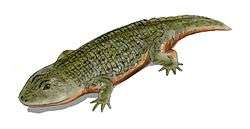Stereospondyli
| Stereospondyls Temporal range: Late Permian–Early Cretaceous | |
|---|---|
 | |
| Life restoration of Peltobatrachus pustulatus | |
| Scientific classification | |
| Kingdom: | Animalia |
| Phylum: | Chordata |
| Order: | †Temnospondyli |
| Clade: | †Stereospondylomorpha |
| Suborder: | †Stereospondyli |
| Families | |
|
See below | |
The Stereospondyli are a group of extinct temnospondyl amphibians. Relative to other early tetrapods (labyrinthodonts), they had simplified backbones, where the whole vertebra was made of a single intercentrum, topped by a neural arch. The whole vertebral structure was rather weak, meaning that most stereospondyls were aquatic. Indeed, the family Plagiosauridae appear to have been wholly aquatic and retained their larval gills in adulthood.
Stereospondyls first appeared during the Late Permian. During this time, the two major groups of stereospondyls, capitosaurians and trematosaurians, appeared. Stereospondyls were relatively uncommon in the Paleozoic, outnumbered by the more diverse euskelians. During this time, they were endemic to Gondwana. Many early groups of temnospondyls became extinct during the Permian-Triassic extinction event but stereospondyls likely survived in Australia or Antarctica, radiating worldwide in the Triassic.
Stereospondyls were the latest-surviving temnospondyl group. With the diversification of crocodile-like archosaurs and an extinction event at the end of the Triassic, most other temnospondyls disappeared. Two families of stereospondyls survived into the Jurassic, and some appear to have survived into the Early Cretaceous in Gondwana. Koolasuchus is the latest known stereospondyl, living during the late Early Cretaceous in what is now Australia in areas that would then have been too cold for crocodiles. Some groups, such as the Metoposaurus, are often associated to mass mortality and bone beds.[1]
Classification
Phylogeny
| |
| ||||||||||||||||||||||||||||||||||||||||||||||||||||||||||||||||||||||||||||||||||||
| | |||||||||||||||||||||||||||||||||||||||||||||||||||||||||||||||||||||||||||||||||||||
| |
| ||||||||||||||||||||||||||||||||||||||||||||||||||||||||||||||||||||||||||||||||||||
| |
Gallery
References
- ↑ Brusatte, S. L., Butler R. J., Mateus O., & Steyer S. J. (2015). A new species of Metoposaurus from the Late Triassic of Portugal and comments on the systematics and biogeography of metoposaurid temnospondyls. Journal of Vertebrate Paleontology. e912988., 2015:
- Yates, A. M. & Warren, A. A. (2000), The phylogeny of the 'higher' temnospondyls (Vertebrata: Choanata) and its implications for the monophyly and origins of the Stereospondyli. Zoological Journal of the Linnean Society 128: 77-121.


